What Are the Benefits of Using Plastic Sheeting Under Concrete Slabs?

When it comes to ensuring the durability, structural integrity, and longevity of concrete slabs, one of the most essential construction practices is the installation of plastic sheeting (also known as vapor barriers or vapor retarders) beneath the slab. This layer of plastic film is more than just a standard building protocol - it provides critical protection that enhances performance and prevents costly structural and environmental issues in both residential and commercial construction projects.
Moisture Control: The Primary Advantage
One of the most compelling benefits of plastic sheeting under concrete slabs is its ability to control moisture. Ground moisture can migrate upward through capillary action, leading to significant problems like mold growth, flooring damage, and slab cracking.
Plastic sheeting serves as a physical barrier, effectively preventing water vapor from penetrating the concrete. This is especially important in areas with high groundwater levels or significant rainfall, where moisture intrusion can compromise interior flooring materials, lead to alkali-silica reaction (ASR), or even degrade adhesives used under flooring finishes.
Preventing Mold and Mildew Growth
Without proper vapor barriers, moisture accumulates underneath floor coverings, providing the ideal breeding ground for mold and mildew. This not only impacts the integrity of the structure but also poses health risks to occupants, including respiratory issues and allergic reactions.
By installing plastic sheeting beneath the concrete slab, builders create a dry, stable environment that inhibits microbial growth, enhancing both building safety and indoor air quality.
Improved Energy Efficiency
Moisture infiltration doesn't only impact structure and health - it also affects a building's thermal performance. A concrete slab with underlying moisture can become thermally inefficient, as water conducts heat away from interior spaces.
By acting as a barrier to both air and water vapor, plastic sheeting enhances insulation effectiveness. This reduces heating and cooling costs, leading to long-term energy savings and more environmentally sustainable construction.
Prevents Floor Covering Failures
Whether you are laying tile, vinyl, hardwood, or carpet, floor coverings can fail prematurely when installed over moisture-laden slabs. Adhesives may not cure properly, or they may degrade over time, causing bubbling, peeling, or lifting of the materials.
Plastic sheeting ensures the slab remains dry, allowing adhesives to function correctly and flooring to maintain its structural and aesthetic quality for decades. This is particularly important for commercial and industrial buildings where floor coverings undergo heavy traffic and wear.
Protects Structural Reinforcement
Concrete slabs are often reinforced with steel rebar or mesh to increase their tensile strength. When moisture penetrates from the soil below, it can lead to rust and corrosion of the steel, causing expansion and cracking of the concrete.
A proper vapor barrier, like polyethylene plastic sheeting, isolates the steel reinforcement from ground moisture, preserving the long-term integrity of the structural system.
Reduces Radon Gas Infiltration
In areas where radon gas is a concern, such as regions with uranium-rich soil, plastic sheeting serves as a critical first line of defense. Radon is a radioactive gas that seeps from the ground and can accumulate to dangerous levels indoors.
While dedicated radon mitigation systems are recommended, plastic sheeting beneath a concrete slab acts as a passive mitigation measure, helping to minimize gas infiltration into the living or working space.

Provides a Clean Working Surface
During construction, plastic sheeting also serves a practical function by creating a clean, dry surface for workers. It minimizes dust, reduces the chance of contamination in the concrete mix, and aids in a cleaner, more controlled pour.
This can be especially useful in controlled environment construction, such as pharmaceutical facilities, laboratories, and cleanrooms, where dust and moisture control is paramount.
Minimizes Curling and Cracking in Slabs
One of the challenges of concrete work is slab curling, where the edges of the slab lift due to uneven drying or temperature changes. When slabs are placed directly on a moisture-absorbent base without a vapor barrier, water is drawn out unevenly, leading to differential shrinkage and curling.
Using plastic sheeting under the slab provides uniform moisture content, which reduces the risk of curling, cracking, and surface imperfections. This contributes to a flatter, more durable slab that requires less maintenance over time.
Enhances Longevity and Reduces Maintenance Costs
Over time, moisture damage can lead to costly repairs, slab replacement, or damage to interior finishes. By integrating plastic sheeting at the time of construction, contractors and property owners reduce the long-term maintenance costs, making it a cost-effective investment.
Initial material and installation costs are minimal compared to the expense of repairing moisture-related damage, which can run into thousands of dollars over the lifespan of a building.
Easy Installation with Modern Materials
Modern vapor barriers are made from high-performance polyethylene films, often in thicknesses ranging from 6 mils to 20 mils or more. These films are lightweight, flexible, and easy to install over compacted subgrades or gravel bases.
Installation best practices include:
- Overlapping seams by at least 6 inches.
- Sealing joints with specialized vapor barrier tape.
- Extending sheeting up walls or columns where appropriate.
- Avoiding punctures or tears during rebar placement or concrete pour.
Compliance with Building Codes and Industry Standards
Most building codes and industry organizations - including the American Concrete Institute (ACI) and the International Building Code (IBC) - recommend or require the use of vapor barriers in slab-on-grade construction.
Incorporating plastic sheeting helps meet code compliance, ensuring that the building passes inspection and performs to modern standards of durability, safety, and sustainability.
Conclusion: Plastic Sheeting Is a Non-Negotiable Asset
The use of plastic sheeting beneath concrete slabs is no longer optional in modern construction - it is a best practice that supports structural integrity, energy efficiency, indoor air quality, and overall building performance. For builders, engineers, and property owners alike, investing in high-quality vapor barriers is essential to protecting concrete structures from the ground up.
Please view the following short video for Using Plastic Sheeting Under Concrete Slabs
